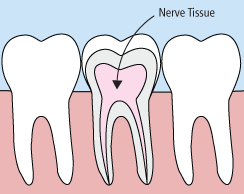Endodontic Therapy

Endodontic therapy, also known as a root canal, is a commonly feared treatment. We have beyond state-of-the-art equipment that detects and helps us treat a root canal. We use digital X-Rays, 3D X-Rays or CBCT, which can detect down to 0.7 of a millimeter to view difficult teeth. We have digital meters that limit the need for excess X-rays. For many years now we have used rotary instruments to effectively clean and seal a root canal. With this technology, times have changed for dentistry. It is more rare for someone to have post-operative pain than it is for them to feel relief that night.
When a tooth is cracked or has a deep cavity, bacteria can enter the pulp tissue and germs can cause infection. If left untreated, an abscess may form. If the infected tissue is not removed, pain and swelling can result.
This not only puts your jawbones at risk for injury, but it is also detrimental to your overall health. It has been shown that bacteria growing in the jawbones chronically can find their way to distant organs, such as the lungs, the heart, or even the brain. Without the proper treatment, your tooth can be a source of infection.
Teeth that require endodontic therapy are not always painful. However, signs you may need a root canal include:
- Severe toothache
- Pain upon chewing or application of pressure
- Prolonged sensitivity to heat or cold
- Dark discoloration of the tooth
- Swelling and tenderness in the nearby gums
WHAT HAPPENS DURING ENDODONTIC THERAPY?
Root canal treatment involves one to three visits during which your general dentist or endodontist removes the infected and/or necrotic tissue. Most times the tooth is filled with a medicine and when appropriate, antibiotics may be given. The tooth is temporarily sealed and the patient heals for a week or two.
After this time, the medicaments are removed and the interior of the tooth is cleaned and sealed.
If your tooth has extensive decay, your dentist may suggest placing a post and crown to strengthen and protect the tooth from breakage.
From here, we hope to help you continue to care for your teeth and gums with regular brushing, flossing, and checkups, so that your restored tooth may continue on for years to come.
Can all teeth be saved?
At times, a root canal is not advised. Tooth extraction may be necessary if:
- Roots are severely fractured
- The tooth does not have adequate bone support
- The tooth cannot be restored
- Root canals are not accessible
In such cases, alternatives thankfully exist. We have information on both bridges and implants, two of the most common replacements we see patients choose for a missing tooth.
